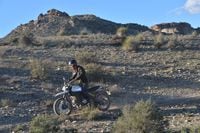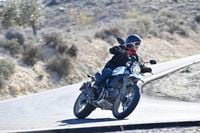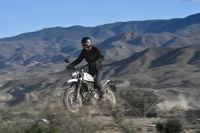The Southwestern California deserts of the late '60s and early '70s were alive with the sound of heavy, steel-framed monsters belting out their parallel-twin battle cry through crass, straight-piped exhausts. Charging through unforgiving terrain, these "desert sleds" as they came to be known, were usually road-going, large-displacement British twins with most all extraneous parts stripped away, leaving a slimmed-down, purpose-driven machine that was capable enough (with the addition of off-road tires and a protective skid plate) to thrash its way through the sand and the mud. Ducati's original Scrambler from the late '60s was a production example of this concept, and a modified version of the same bike went on to win the Baja 500 race in 1969.
With Ducati's recent Scrambler series making waves across the U.S. and other parts of the world, the choice was made to design a motorcycle around the existing Scrambler frame that incorporated the key aspects of the traditional desert sled, while keeping with the spirit of the "Scrambler Ducati" lifestyle brand. The air-cooled, 803cc V-twin engine was carried over unchanged, and is contained by a beefed-up version of the original steel-tube trellis frame. The previous frame design used the engine as a stressed member, but the inclusion of extra frame bracing now means you can thrash the Desert Sled to your heart's desire without worrying about undue strain. A lengthened aluminum swingarm means the overall wheelbase is stretched to 53.9 inches, a modification Ducati made to add stability. Spoked wheels (now 19 inches in the front and 17 inches in the rear) are fitted with Pirelli Scorpion Rally STR tires that truly look the part. The Desert Sled shares the same 24-degree head angle as other Scrambler models, however newly shaped handlebars along with the relaxed 30mm offset of the top triple clamp is designed to provide more controllable steering in situations with little grip.
Overall ground clearance has been increased to 9.4 inches thanks to a longer 46mm KYB fork and a KYB rear shock, both with 7.9 inches of travel. Both front and rear suspension are adjustable (the fork is fully adjustable, the shock is adjustable for spring preload and rebound damping), unlike on the base Scrambler which only offers spring preload and rebound-damping adjustment on the shock. The Desert Sled’s 33.9-inch seat height may make the bike’s 456-pound (claimed) wet weight difficult to manage for shorter riders, but luckily Ducati will offer the same re-shaped Sled-specific seat in a low model too. Metal guards for the headlight and oil cooler ensure that rogue rocks won’t cause damage, and a skid pan keeps the underside of the engine from being mangled by hidden obstacles. The stock footpegs are cushioned for both the rider and the passenger, with sharper, more enduro-friendly billet aluminum pegs being offered as factory options.
Flogging the Desert Sled in Spain’s barren southern region was as much of a test for the Sled as one could hope for, providing a constant barrage of the best (and worst) nature could offer in the ways of challenging and technical terrain. The Desert Sled faced deep sand washes, dusty fire roads, dicey shale, winding mountain pavement and hard-packed dirt, tackling all areas with tenacity. The increased suspension travel and braced frame contributed heavily to the sturdiness of the machine, and the longer wheelbase and handlebar offset made steering input consistent on loose terrain. Fresh engine mapping combined with a redesigned throttle tube made power delivery easier to manage than the previous Scrambler, which was helpful in precarious off-road sections where precise throttle control meant the difference between safely climbing the summit of a Spanish mountain range or losing the bike over the edge of a precarious cliff.
As much of an off-road vision as Ducati had for the Desert Sled, there’s still something to be said for on-road performance. Carving through canyons far above Almería was a breeze, with power delivery smooth and predictable and braking from the four-piston front caliper more than enough to slow the weight of the bike safely. The ABS engages predictably and can also be turned on or off while at a stop. At times, the transmission felt somewhat clunky, as more than a few false neutrals were found throughout the day. The gauge, unchanged from the original Scrambler model, is easy to read and provides a very simple layout of basic information.
The Desert Sled comes as something of a surprise, most notably the overall capabilities of the machine, as it far outshined initial speculations. As hefty of a price as it comes at (MSRP $11,495) one might beg the question as to the rationale of buying a desert sled as opposed to purchasing a Scrambler Icon as well as a dedicated dirt bike for roughly the same cost, but the whole charm of the Desert Sled is its ability to chug down the road solidly at comfortable freeway speeds while still retaining the ability to abandon the comfort of the tarmac at a moment’s notice in favor of that oh-so-inviting tortuous dirt road that you’ve always wanted to investigate. The charm and free spirit of the early ‘70s is alive and well in Ducati’s Desert Sled, and if you’re a fan of the Italian marque and crave a purpose-built bike that’s as capable on and off-road as it is fondly reminiscent of a bygone era, then it just might be your match made in heaven.























/cloudfront-us-east-1.images.arcpublishing.com/octane/QSTCM6AVEZA5JJBUXNIQ3DSOF4.jpg)
/cloudfront-us-east-1.images.arcpublishing.com/octane/U4I7G625B5DMLF2DVIJDFZVV6M.jpg)
/cloudfront-us-east-1.images.arcpublishing.com/octane/B6XD6LS6IVCQPIU6HXDJSM3FHY.jpg)
/cloudfront-us-east-1.images.arcpublishing.com/octane/ICL63FEDDRDTTMINYICCEYGMDA.jpg)
/cloudfront-us-east-1.images.arcpublishing.com/octane/FCGZHQXRBZFLBAPC5SDIQLVF4I.jpg)
/cloudfront-us-east-1.images.arcpublishing.com/octane/WNOB6LDOIFFHJKPSVIWDYUGOPM.jpg)

/cloudfront-us-east-1.images.arcpublishing.com/octane/X33NU3E525ECRHXLNUJN2FTRKI.jpg)
/cloudfront-us-east-1.images.arcpublishing.com/octane/6KKT5NNL2JAVBOXMZYS5ZO76YA.jpg)
/cloudfront-us-east-1.images.arcpublishing.com/octane/J5RKG5O455GMPGQRF2OG6LRT7A.jpg)
/cloudfront-us-east-1.images.arcpublishing.com/octane/GX2CIZKQVRH2TATDM26KFG2DAE.jpg)
/cloudfront-us-east-1.images.arcpublishing.com/octane/ZWIDYSAKQZHD5BHREMQILXJCGM.jpg)
/cloudfront-us-east-1.images.arcpublishing.com/octane/CYUHJZCTSJCH3MRAQEIKXK7SCQ.jpg)
/cloudfront-us-east-1.images.arcpublishing.com/octane/LKOFINY56FCXJCANJ5M7ZDQUBY.jpg)
/cloudfront-us-east-1.images.arcpublishing.com/octane/4NBPDACMWJH63JQYJVK3QRBDZI.jpg)
/cloudfront-us-east-1.images.arcpublishing.com/octane/KKHQHRR3FJGX7H2IPU6RALMWG4.jpg)

/cloudfront-us-east-1.images.arcpublishing.com/octane/5IOFS5JAE5FOXMNA23ZRAVVYUU.jpg)
/cloudfront-us-east-1.images.arcpublishing.com/octane/CGXQ3O2VVJF7PGTYR3QICTLDLM.jpg)

/cloudfront-us-east-1.images.arcpublishing.com/octane/OQVCJOABCFC5NBEF2KIGRCV3XA.jpg)
/cloudfront-us-east-1.images.arcpublishing.com/octane/OPVQ7R4EFNCLRDPSQT4FBZCS2A.jpg)
/cloudfront-us-east-1.images.arcpublishing.com/octane/YBPFZBTAS5FJJBKOWC57QGEFDM.jpg)
/cloudfront-us-east-1.images.arcpublishing.com/octane/W5DVCJVUQVHZTN2DNYLI2UYW5U.jpg)